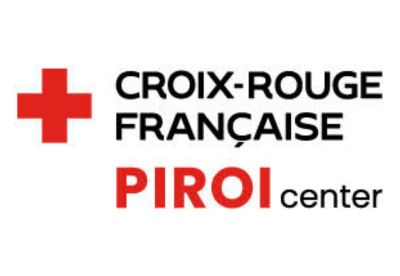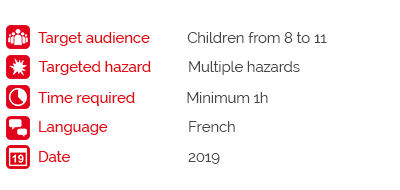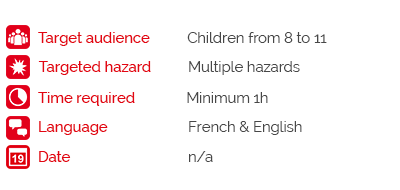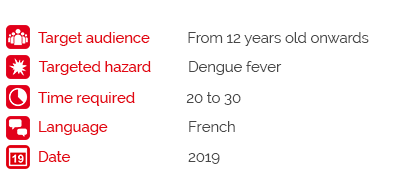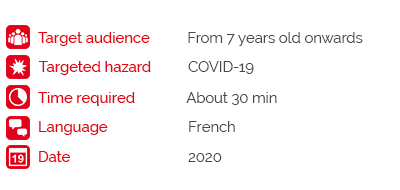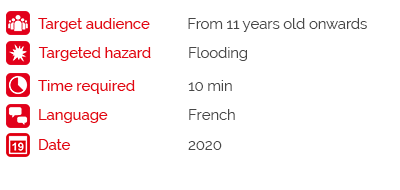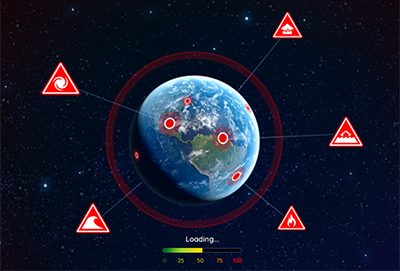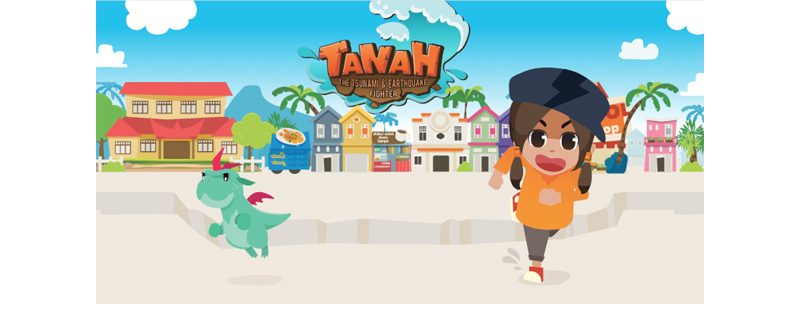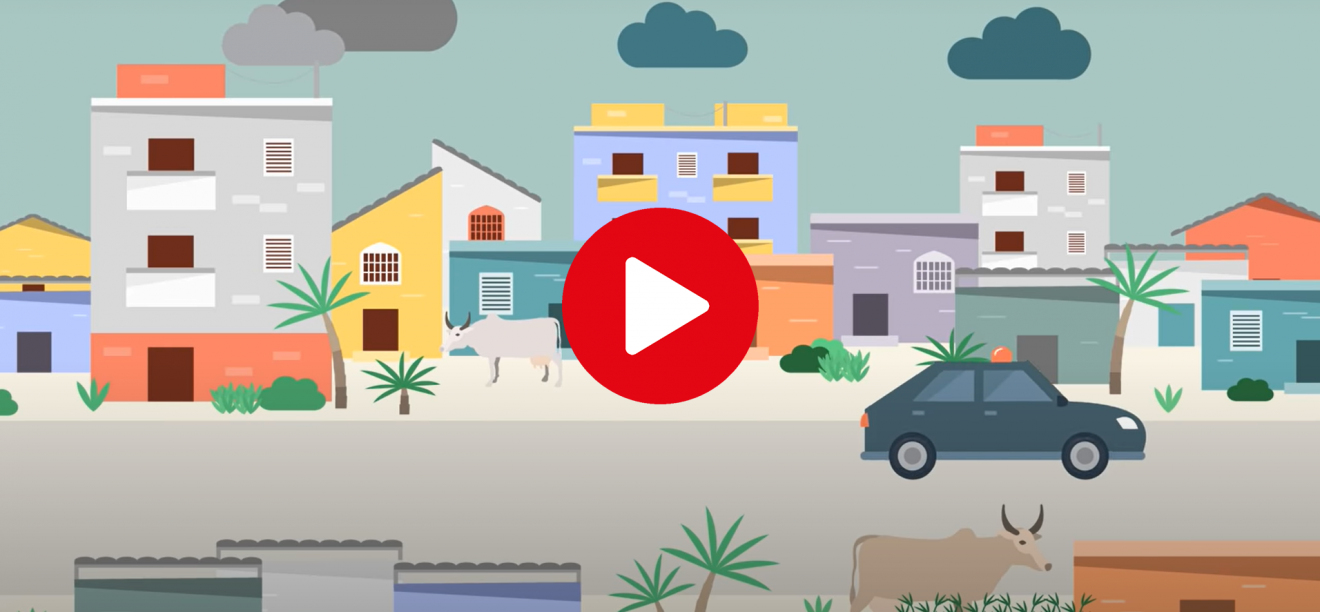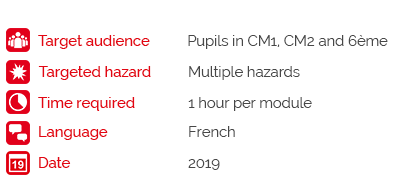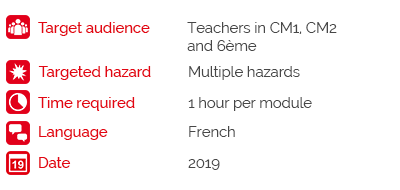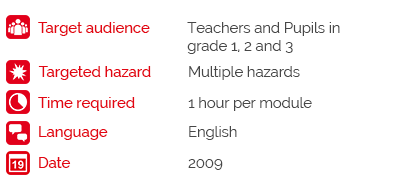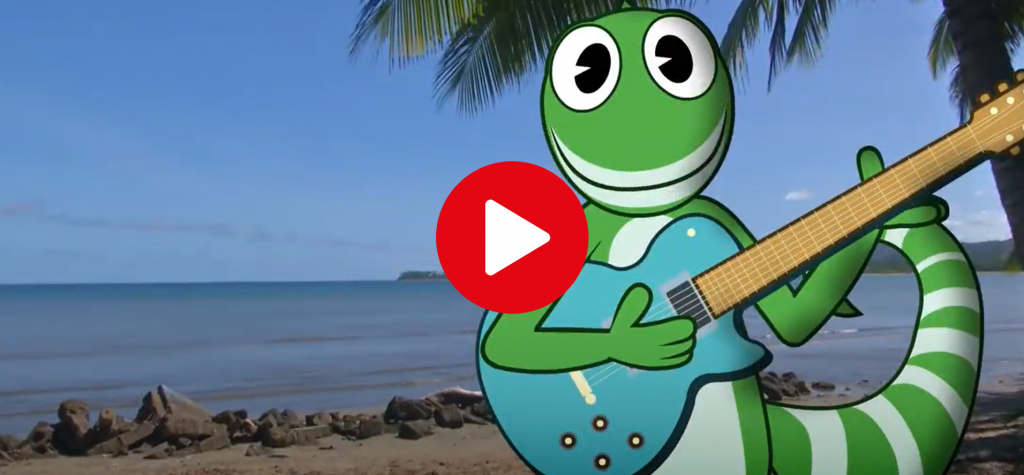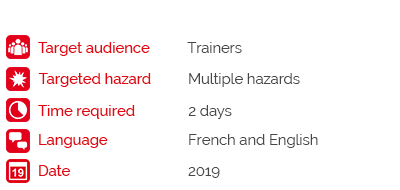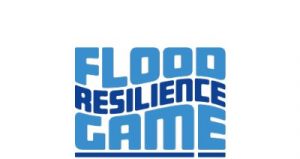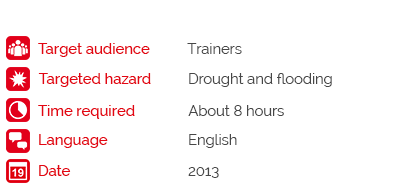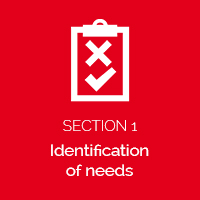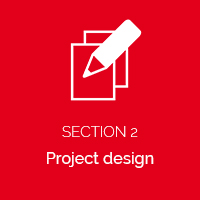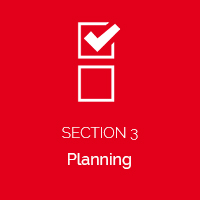
For many years, DRR actors have been raising awareness of disaster risks among states and populations with the aim of (i) engaging and influencing decision-makers to change the population, and (ii) generating individual and/or collective change through knowledge of natural and/or climatic hazards and the application of appropriate behaviour in real-life conditions. Many tools have been developed for this purpose.
To enable disaster risk education in schools, it is essential to develop pedagogical tools that address both teachers and students.
See corresponding tools
- Awareness among the public
- Education in schools and extracurricular activities
- Disaster preparedness in schools
- Capacity building
 TOOL 1 – Board Game ”Danzé nou zil”
TOOL 1 – Board Game ”Danzé nou zil”
(The Mauritius Red Cross)
Objective: To provide an interactive tool to raise children’s awareness of disaster risks.
|
Description: The game consists of 100 numbered squares, illustrated with scales, landscapes, natural hazard symbols (swell, cyclone, landslide, flood and tsunami), question marks and a lit lamp, and five sets of 20 information cards or questions. The game can be played by 2 to 6 players. The player moves from square to square according to the number on the dice. A card is then drawn with fact or question. Added value of the tool: Playful and participative game adapted for children. Attractive for children with the graphics and the giant dice |
Point of caution: Teenagers and adults do not play this type of board game. The game can take time to set up and play in a group
|
 TOOL 2 – Board Game “Ilot Risk”
TOOL 2 – Board Game “Ilot Risk”
(Oceania Red Cross)
Objective: To learn how to spot the warning signs of risks linked to natural hazards and to understand the safety instructions for each situation.
|
Description: Ilôt Risk can be played in teams or individually, by 2 to 6 players. The game includes natural hazard boxes which block the players, who then must implement instructions to face these hazards and eliminate risk across the island. There are 3 families of cards: (i) 55 turtle cards representing the number of squares to be covered, (ii) 21 red hazard cards (tsunami, earthquake, landslide, flood, bushfire, cyclone and volcano) and (iii) 42 green instruction cards. Players start with 6 cards. The player must lay down a danger card of their choice to delay their opponent. In this case, the blocked player must cover the danger card with the corresponding instruction card to advance. Added value of the tool: Covers all hazards, with hazard maps and instructions adapted to the context |
Point of caution: Rules are difficult to understand at first glance. Children need to be educated about disaster risk before, as well as during, school-based sessions |
 TOOL 3 – Game “buzz la dengue et Pik Pik”
TOOL 3 – Game “buzz la dengue et Pik Pik”
(PIROI, Reunion Island)
Objective: To learn how to fight dengue fever through protective actions. To raise players’ awareness of the causes and consequences of dengue fever by providing actions to reduce the risk of spread and contagion.
|
Description: A strategy game played in teams. Divide the players into 2 teams with 3 people in the “mosquito” team and 3 “human” people facing each other. In each turn, the teams decide on a strategy within 15 seconds to decide on the action to be taken. Added value of the tool: Interactive game with clear graphics. Accompanied by a booklet for facilitators |
Point of caution: The rule is not easy to understand without prior guidance. Requires practice before raising awareness among the public. Requires preparation time and specific materials
|
 TOOL 4 – Game “Covid-19, kossassa ?”
TOOL 4 – Game “Covid-19, kossassa ?”
(PIROI, Reunion Island)
|
|
Objective: To raise awareness about Covid-19 and protection measures.
|
Description: Through a game board, 2 to 4 players will be challenged by Covid-19 and will implement barrier gestures through questions/answers and challenges. Each player stands on the “Start” square, throws a dice and moves forward by the number of squares indicated on (i) the purple “disease” square and (ii) the green “protection” card. The first player to reach the “Arrival” square wins the game. The game includes challenges: simulation of barrier gestures, pepper experiment and hand washing workshop. Added value of the tool: Interactive game with clear graphics and practical challenges. Accompanied by a booklet for facilitators |
Points of attention: The game requires equipment such as a table large enough to set up the game board and, if possible, to be near access to water.
|
 TOOL 5 – Game “Risk Peï”
TOOL 5 – Game “Risk Peï”
(PIROI, Reunion Island)
Objective: To provide an interactive tool to raise awareness of disaster risk among children and adults.
|
Description: Game representing Reunion Island: each square is linked to a question contextualised to the territory and dealing with the themes of the environment, risks, means of protection, historical natural events, etc. Added value of the tool: Interactive game for children Point of caution: No rules for the game. Fun and participatory game that engages children more than adults |
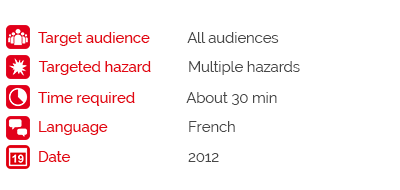 |
 TOOL 6 – Posters
TOOL 6 – Posters
(The Malagasy Red Cross)
Objective: To raise awareness of what to do before, during and after a cyclone
|
Description: Posters explaining what to do in case of a cyclone. Added value of the tool: In local language for easy comprehension. Selection of simple graphics. Point of caution: Only in local language. Limited preparedness actions and no link to early warning system |
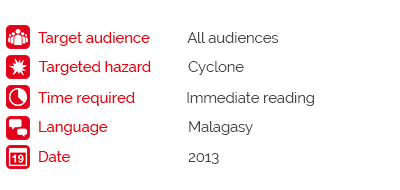 |
 TOOL 7 – Poster and leaflet on COVID-19
TOOL 7 – Poster and leaflet on COVID-19
(PIROI, Reunion Island)
Objective: To raise public awareness through visual representation.
|
Description: Poster and leaflet in local and French language explaining symptoms, instructions and different barrier gestures to protect oneself against COVID-19. Added value of the tool: Visuals and information that can be understood by everyone. Point of caution: Need for regular updates, according to national instructions. Place posters in strategic locations to be seen by a larger number of the population |
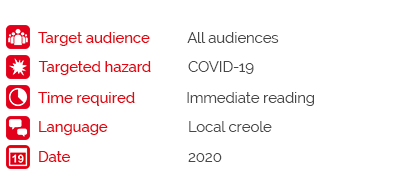 |
 TOOL 8 – Community Early Warning System posters
TOOL 8 – Community Early Warning System posters
(Humanity and Inclusion & CARE, Madagascar)
Objective: To explain what to do in the event of a cyclone, according to community warnings.
|
Description: A series of 4 posters for the population indicating priority actions, according to the progress and intensity of the cyclone. The measures are indicated by drawings and a short explanation under each drawing. The posters refer to the colour codes visible through a flag set up in the community. Added value of the tool: Messages and images contextualised to a specific hazard and to communities; Adapted to an illiterate population through images. Point of caution: Exists only in local language. The document must be contextualised according to national and local practices and alert codes
|
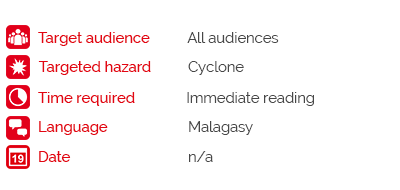 |
 TOOL 9 – Posters on 7 natural hazards
TOOL 9 – Posters on 7 natural hazards
(PIROI, Reunion Island)
Objective: To learn the right behaviours to adopt in order to face natural risks in Reunion Island.
|
Description: Posters on prevention instructions for each hazard in the form of a comic strip. Added value of the tool: Clear messages and visuals in relation to the natural hazard Point of caution: Simplistic graphics for adults |
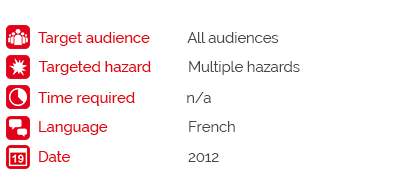 |
 TOOL 10 – Paper pans
TOOL 10 – Paper pans
(PIROI, Reunion Island)
Objective: To learn the right behaviour to adopt in order to face natural risks in Reunion Island.
|
Description: A series of questions based on natural hazards. Due to manual influence, the player can ask a specific question. Added value of the tool: Interactive learning and randomly selected questions. Point of caution: Game more suitable for a young audience |
 |
 TOOL 11 – Tale “Island of a thousand dangers”
TOOL 11 – Tale “Island of a thousand dangers”
(PIROI: Reunion Island, Mayotte, Union of Comoros, Mauritius, Seychelles)
Objective: To describe the various natural hazards in the Indian Ocean, and the preparedness measures that the population can put in place.
|
Description: A storybook explaining the presence of natural hazards in Seychelles, Union of Comoros, Mauritius, Reunion Island and Madagascar (cyclone, volcano, forest fires, tsunami and earthquake). Through a story, 5 mascots will face the different natural hazards, and will apply preparation and prevention measures. Added value of the tool: Suitable for children with images and island mascots. 2 languages: French and local language. Accompanied by an animator’s booklet. Point of caution: A facilitator must be trained in storytelling but the child can read it directly. Only for a very young audience |
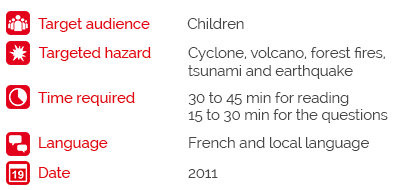 |
 TOOL 12 – Comics “The Adventures of Towabonga Reef”
TOOL 12 – Comics “The Adventures of Towabonga Reef”
(Mayotte Nature Environnement)
Objective: To discover the composition and diversity of coral reefs and why it is important to protect them.
|
Description: A comic book that tells the story of four corals in a reef. Through their adventures, we learn about the functioning of a coral reef and the biodiversity that lives within. Added value of the tool: Comprehensive cartoon explaining the coral reef, the dangers and how to protect the environment. Point of caution: Not accessible to illiterate and foreign audiences |
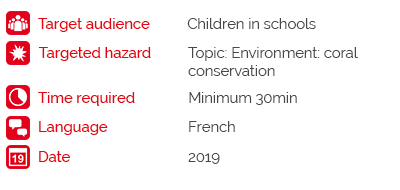 |
 TOOL 13 – Comics “Remember the right things to do”
TOOL 13 – Comics “Remember the right things to do”
(PIROI, Reunion Island)
Objective: To explain in a playful way and visualise the actions to be taken “before, during and after” a disaster.
|
Description: The comic strip on disaster risks includes a leaflet explaining the hazard and examples of measures to take before, during and after the event. This is applied to each hazard present in Reunion Island: cyclone, vegetation fire, flood, earthquake, tsunami and volcanic eruption. Added value of the tool: Accessible to any audience that can read French. Short and precise messages Point of caution: Not accessible to illiterate and foreign audiences |
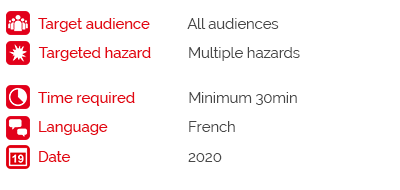 |
 TOOL 14 – Serious Game “A zot et les zinondations”
TOOL 14 – Serious Game “A zot et les zinondations”
(PIROI, Reunion Island)
Objective: To raise awareness about what to do before, during and after a flood.
|
Description: A game consisting of “action” and “information” cards to be undertaken before, during and after a flood. The cards explain what type of actions to take, depending on the person(s) (adult, child, family) and the time (before, during and after) Added value of the tool: Cards with full description and drawings for easy understanding Point of caution: Requires a minimum of knowledge about flooding to play |
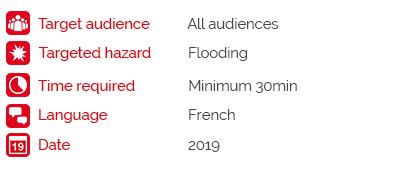 |
 TOOL 15 – Serious Game “Disaster Challenge Game”
TOOL 15 – Serious Game “Disaster Challenge Game”
(The Seychelles Red Cross Society)
|
|
Objective: To raise awareness of the natural hazard, its consequences and actions to reduce disaster risk.
|
Description: The game is composed of a board with different squares, and cards with questions/answers concerning causes, consequences, DRR methods, and general information on natural hazards in Seychelles. Added value of the tool: Questions targeting hazards in Seychelles as well as broader issues such as the environment Point of caution: Availability of the board and cards only, lacking associated game rules |
 |
 TOOL 16 – Virtual reality game for floods
TOOL 16 – Virtual reality game for floods
(The French Red Cross)
Objective: To make the general public aware of the risks of flooding, the importance of being prepared and to encourage further training.
|
Description: A “SideQuest” application download and accompanying virtual reality scenario implemented in about ten minutes, which takes place in several stages (i) technical introduction, (ii) thematic introduction, (iii) contextualisation, (iv) Catakit sequence, and (v) House sequence. Point of caution: Requires a headset, an application, and a smartphone or tablet with an internet connection. Need the software to do the virtual exercise. Need to train the facilitators beforehand. Provide additional visibility tools to explain what the exercise is about |
Added value of the tool: Targets young adults and adults. Can be used in any location but with support from PIROI. |
 TOOL 17 – 3D Game ”Stop Disasters!”
TOOL 17 – 3D Game ”Stop Disasters!”
(UNDRR)
Objective: To manage and develop a locality, in a limited time, to prepare it for natural disasters.
|
Description: This 3D game invites you to take the place of the town planning department of a town. To avoid the impending disaster, you must build earthquake-proof houses, erect dykes or flood expansion zones or control urbanisation in risky areas. Added value of the tool: Free online game, with different levels and in different geographical areas. Point of caution: Only accessible with internet access, and in English. The game must be played at least twice. |
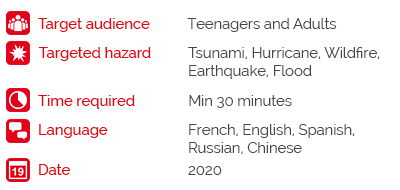 |
 TOOL 18 – Tanah: The Tsunami and Earthquake Fighter – A mobile application to help children prepare
TOOL 18 – Tanah: The Tsunami and Earthquake Fighter – A mobile application to help children prepare
(UNESCO Asia-Pacific region)
Objective: To provide fun, interactive challenges and increase hazard awareness while learning key disaster risk reduction concepts.
|
Description: Educational mobile disaster preparedness application designed for children and families. The game follows the heroine Tanah as she learns to prepare for and protect herself from tsunamis and earthquakes. Added value of the tool: Fun game Point of caution: Suitable for a younger audience rather than teenagers |
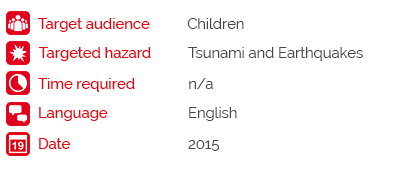 |
 TOOL 19 – Extreme Event Game
TOOL 19 – Extreme Event Game
(National Academy of Sciences’ Koshland Science Museum)
Objective: To raise awareness about building community resilience to disaster.
|
Description: Extreme Event is an award-winning role-playing game that gives participants an insight into what it takes to build community resilience in the face of disaster. Players work together to make decisions and solve problems in a fast-paced, engaging disaster simulation. Added value of the tool: Possibility to make your own game Point of caution: Requires prior knowledge of disaster risk |
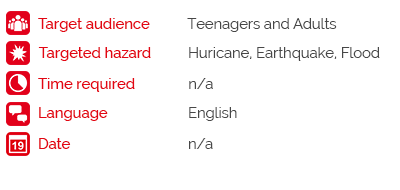 |
 OUTIL 20 – Video: Preparing for a flood Major Disasters
OUTIL 20 – Video: Preparing for a flood Major Disasters
(IFRC & Shikana)
Objective: To learn how to prepare and react appropriately in case of a disaster (e.g., flood, earthquake, heat wave, tsunami, volcano, storm, etc.)
|
Description: A series of videos with advice on what to do before and during an event, as well as on prevention measures. A video is also available on how to make a family emergency plan and build a disaster kit. Added value of the tool: Clear explanations with visuals. Point of caution: Videos not adapted to vulnerable areas and people exposed in rural areas. |
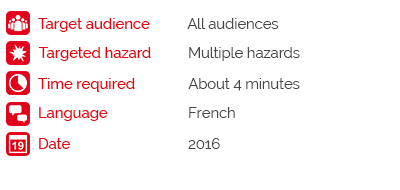 |
 TOOL 21 – Short guide – Earthquake-proof houses
TOOL 21 – Short guide – Earthquake-proof houses
(The BRGM and the DEAL in Mayotte)
Objective: To learn how to prepare and react appropriately in case of a disaster (e.g. flood, earthquake, heat wave, tsunami, volcano, storm, etc.)
|
Description: Numerous visuals allow you to understand how to build a house while respecting earthquake resistant standards. Added value of the tool: Very specific booklet on the subject of construction. Clear explanations with visuals. Points of caution: Adapt to the target audience. Tool too complex for people with no previous knowledge, and too simple for experienced professionals.
|
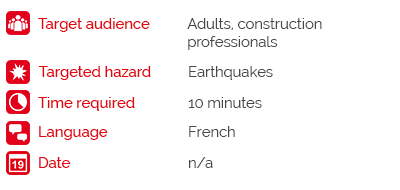 |
 TOOL 1 – Pupil’s Booklet Paré pas Paré
TOOL 1 – Pupil’s Booklet Paré pas Paré
(PIROI, Reunion Island)
Objective: To help pupils in CM1, CM2 and 6ème learn about the risks of disasters linked to the natural and climatic hazards that can occur in Reunion Island.
|
Description: The pupil’s booklet includes:
Added value of the tool: Very well illustrated, very attractive and adapted to the target audience. |
Point of caution: Built to last for 3 years of schooling, needs regular updating and validation by the Ministry of Education |
 TOOL 2 – Teacher’s Booklet Paré pas Paré
TOOL 2 – Teacher’s Booklet Paré pas Paré
(PIROI, Reunion Island)
Objective: To support teachers in implementing disaster risk education sessions as part of the school curriculum. This booklet provides both background information and facilitation techniques.
|
Description: The teachers’ booklet includes:
Added value of the tool: Very well illustrated guide, easy to use for teachers and mirrored with the student booklet |
Point of caution: Built to last for 3 years of schooling, needs regular updating and validation by the Ministry of Education |
 TOOL 3 – Risk Reduction Methods Handbook
TOOL 3 – Risk Reduction Methods Handbook
(UNDRR, Tanzania)
Objective: To support primary school teachers of Grades 1, 2 and 3 in disaster risk reduction and promote a culture of prevention in Tanzania.
|
Description: This guide is divided into 3 sections (one for each level), and includes 15 chapters. For each chapter there is a series of exercises. A chapter will often be covered twice during the school curriculum (e.g., Grade 1 and Grade 3 with different exercises for each level), which reinforces the appropriation of the messages by the students. Added value of the tool: A comprehensive handbook that covers a wide range of hazards including industrial risks, conflict, terrorism, HIV. For each hazard, the handbook includes exercises, adapted to different levels. |
Point of caution: Front used is not easy to read. Some chapters are very short. |
 TOOL 4 – Teacher’s Guide, Disaster Management Education
TOOL 4 – Teacher’s Guide, Disaster Management Education
(The DGSC and the PNUD, Union of Comoros)
Objective: To support primary school teachers and pedagogical advisors in the implementation of disaster risk awareness sessions in schools.
|
Description: The guide includes 8 modules, i.e. 7 chapters on natural and climatic hazards, and 1 chapter on climate change. The tool is contextualised for the Union of Comoros archipelago. Added value of the tool: Very well illustrated, user-friendly and easy to understand. Good popularisation of scientific phenomena Point of caution: The introductory module on risks in general is very brief. The guide is contextualised for the Union of Comoros archipelago. |
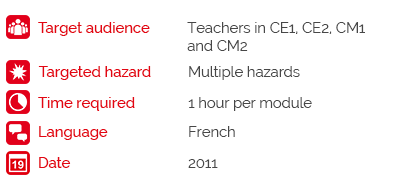 |
To go further…
 A Student’s guide to Disaster Risk Reduction
A Student’s guide to Disaster Risk Reduction
(UNESCO, International)
Objective: To introduce teachers, students and parents to concepts and best practices in disaster preparedness and response.
| Description: The guide explains the basic concepts of DRR, explores the psychosocial effects of disasters and provides tips for different activities that young people can do in the classroom, at school, at home and in the community to improve disaster preparedness and response. A comic book illustrates the different chapters | 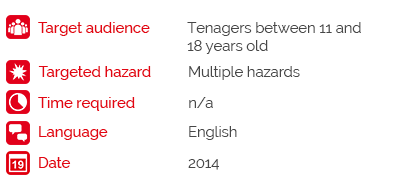 |
 TOOL 1 – Emergency Evacuation Plan
TOOL 1 – Emergency Evacuation Plan
(Save The Children in Fiji)
Objective: To describe school-based disaster preparedness, warning and risk reduction actions.
|
Description: A series of cards for facilitators and children in DRR clubs in schools explaining (i) how to prepare for disasters, (ii) how to receive disaster warnings, (iii) what preparation is good for which hazards and (iv) how to reduce hazards. The maps show eight main hazards in Fiji. They should be used as large picture prints, with simple information on the reverse side that the facilitator can use to discuss hazards, vulnerability and disasters. Added value of the tool: Maps explaining actions by natural and climatic hazards |
Point of caution: Exists only in English. Lack of illustration to be inclusive |
 TOOL 2 – Iggy “Disaster risk reduction songs for children”
TOOL 2 – Iggy “Disaster risk reduction songs for children”
(Health Songs International for Save the Children Fiji)
Objective: To teach children about emergency and safety procedures at school.
|
Description: The film is based on DRR and safety key messages, which are evidence-based, consensus-based and action-oriented. To make the film more teacher-friendly, we have divided it into seven sections. Each section instructs children how to prepare and protect themselves in a specific incident. Added value of the tool: The film is warm, familiar, light, friendly and caring Point of caution: No specific comments except that this tool is in English only |
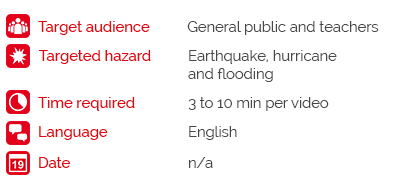 |
 TOOL 3 – Eco-School Disaster Risk Reduction Toolkit – Conduct a child-centred vulnerability and capacity assessment for your school and community
TOOL 3 – Eco-School Disaster Risk Reduction Toolkit – Conduct a child-centred vulnerability and capacity assessment for your school and community
(PIROI, Reunion Island)
Objective: To help teachers, school leaders and community members increase support for children’s participation in school-based disaster preparedness and management.
|
Description: This toolkit provides a practical guide on how to conduct an EVCA with and for children as part of wider DRR initiatives in schools. Added value of the tool: Gives concrete examples and case studies Point of caution: Need for DRR training beforehand. Document only in English |
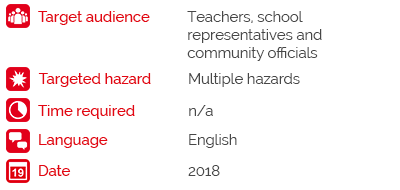 |
To go further…
 Fiji School Disaster Managment Guide
Fiji School Disaster Managment Guide
(Save The Children aux Fidji)
Objective: To raise awareness on disaster and emergency management in schools.
|
Description: This guide includes:
|
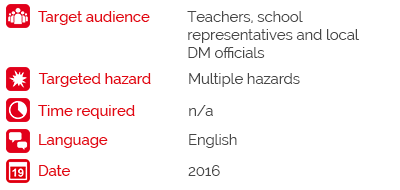 |
 TOOL 1 – Technical and pedagogical training guide for facilitators
TOOL 1 – Technical and pedagogical training guide for facilitators
(PIROI, Reunion Island)
Objective: To support training facilitators within the DRR cluster with information on the organisation of the training, the target audience, the content and the facilitation methods.
|
Description: The training is aimed at people involved in the facilitation of DRR projects, i.e. volunteers, educational staff, etc. At the end of the training, participants should be familiar with both the content and the facilitation techniques of awareness-raising activities. Main elements of the training content (duration: 2 days)
|
Added value of the tool: Clear and well structured, real added value for the facilitator. Available in English and French Point of caution: Fairly rapid information on the content of the training, no reference to the slides |
 TOOL 2 – Assessment of training needs
TOOL 2 – Assessment of training needs
(PIROI, Reunion Island)
Objective: To assess the existing capacities and training needs of volunteers.
|
Added value of the tool: Knowing how to orientate training, and enabling it to better adapt to needs. Point of caution: Digitise the tool before use for greater efficiency. |
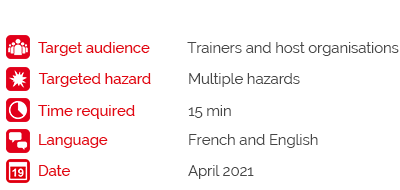 |
 TOOL 3 – Final training evaluation
TOOL 3 – Final training evaluation
(PIROI, Reunion Island)
Objective: To receive participant feedback on training content and format to adapt material and improve the quality of the training.
|
Added value of the tool: Receive feedback on the training and identify successes and areas for improvement Point of caution: Requires an investment to compile the results of the spider graphs |
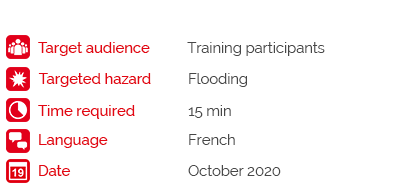 |
 TOOL 4 – Disasters and Natural Hazards Manual for Facilitators
TOOL 4 – Disasters and Natural Hazards Manual for Facilitators
(Seychelles Red Cross Society)
Objective: To support facilitators, teachers and club leaders responsible for raising awareness of DRR in schools and community groups in Seychelles.
|
Description: The manual consists of 10 sessions: one general session on DRR and 9 sessions on a specific natural and climatic hazard. Added value of the tool: Very clear, illustrated, updated in 2020. Comprehensive manual, covering 9 different hazards. Point of caution: Lack of practical exercises |
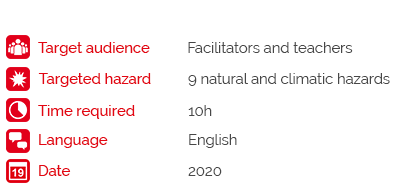 |
 TOOL 5 – Methodological Guide on Dengue Fever
TOOL 5 – Methodological Guide on Dengue Fever
(PIROI, Reunion Island)
Objective: To present the strategic and operational axes of a dengue risk awareness project.
|
Description: Composed of 3 modules, this training course provides an understanding of the principles of an epidemic, how to organise an awareness-raising action and the tools available on the subject of dengue. Added value of the tool: Comprehensive guide with both theoretical background and awareness-raising games. The annexes are well detailed. Points of caution: Update the data before each training session. |
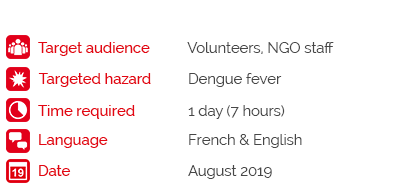 |
 TOOL 6 – Training material on “Flooding”
TOOL 6 – Training material on “Flooding”
(PIROI, Reunion Island)
Objective: To run a two-day training course for future flood facilitators.
|
Description: PPT training material with an outline of the two days, examples of ice breakers, an explanation of the project, a theoretical part on flooding and finally a practical part via the Serious Game. Added value of the tool: Very well designed training, good balance between knowledge acquisition and practice Points of caution: Adapt the activities, practices and games to the size of your group |
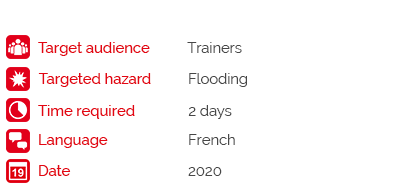 |
 TOOL 7 – Trainer’s Fact Sheet
TOOL 7 – Trainer’s Fact Sheet
(PIROI, Reunion Island)
Objective: To support the host organisation and trainers in the logistical preparation of a training event to avoid unforeseen incidents
|
Description: Provides a logistical checklist and reminder of things to think about before, during and on the last day of the course. Added value of the tool: Checklist to make sure you don’t forget anything, help with the logistical organisation to ensure that the training runs as smoothly as possible. Points of caution: Non-exhaustive list, to be adapted to training needs and location |
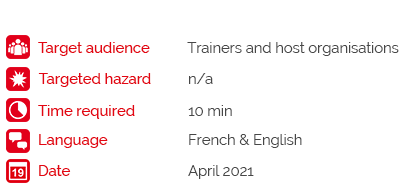 |
 TOOL 8 – Flood resilience game
TOOL 8 – Flood resilience game
(Centre for Systems Solutions (CRS) and the International Institute for Applied Systems Analysis)
Objective: To help participants – such as NGO staff working on flood-related programmes – to identify new policies and strategies that improve flood resilience.
|
Description: The Flood Resilience Game is an educational game that allows players to experience, explore and learn about flood risk and community resilience in river valleys. Added value of the tool: Comprehensive game covering the field of disaster resilience. Very practical for developing a DRR and resilience project. Point of caution: Tools for staff and volunteers. Must be trained beforehand. Only in English but possibility to translate the game into local language |
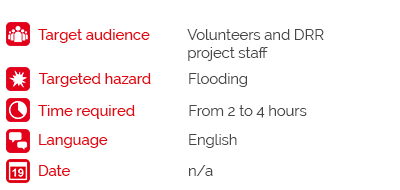 |
